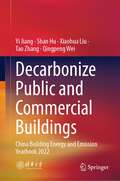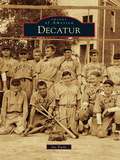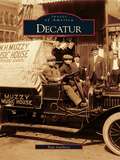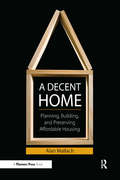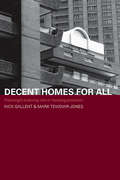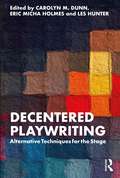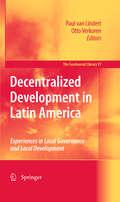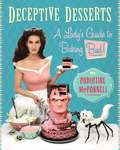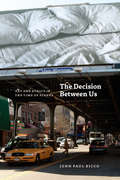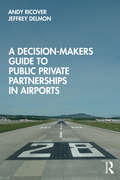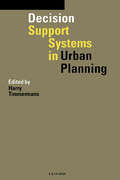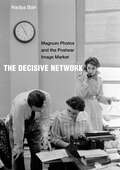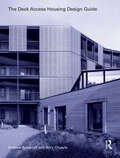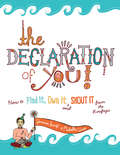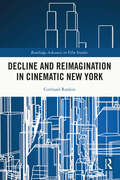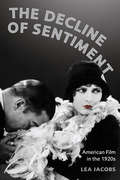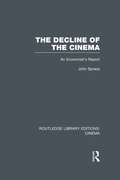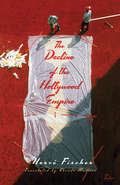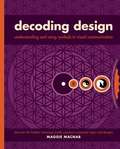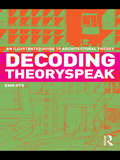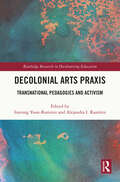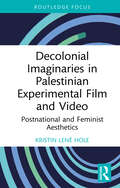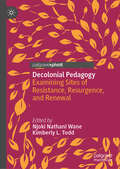- Table View
- List View
Decarbonize Public and Commercial Buildings: China Building Energy and Emission Yearbook 2022
by Yi Jiang Shan Hu Xiaohua Liu Tao Zhang Qingpeng WeiOne of the key motivations and goals for China's social and economic development is the dual carbon target. Building is one of the most important sectors to reduce emissions and save energy, accounting for more than 20% of China's primary energy consumption and carbon emissions. This book analyzes the energy consumption of China's buildings sector in four categories, their characteristics and technologies to improve energy efficiency, and examines the greenhouse gas emissions of China's buildings, including building construction embodied emission and building operation emissions. In particular, this book discusses the ways to achieve carbon neutrality targets for China's public and commercial building sectors. This book also analyzes the energy mix, energy intensity, and technological prospects for achieving energy and carbon targets in the public and commercial building sectors. This book contains a large amount of survey data, monitoring data, and case studies. The debate on technologies and policies is underpinned by a variety of evidence and research that has been ongoing for more than a decade. The information, data, and policy recommendations will be of interest to a national and international audience working in the fields of energy, climate change, engineering, and building science.
Decatur (Images of America)
by Joe EarleDecatur proudly proclaims itself a city of "homes, schools, and places of worship." While that motto might seem to describe any number of small towns, the words accurately capture the essence of Decatur, a place of fine and humble homes, well-regarded schools, and large, active churches. Founded by the Georgia legislature in 1823 to be the county seat of DeKalb County, Decatur took its name from Commodore Stephen Decatur, a U.S. naval hero of the early 1800s. In the years since, Decatur has grown into a busy suburb of neighboring Atlanta, produced Agnes Scott College, and attracted both the Scottish Rite Children's Hospital and Columbia Theological Seminary. Decatur has been home to fascinating Georgians, including Civil War memoirist Mary Gay and writer Rebecca Latimer Felton, the first woman to be seated as a U.S. senator (if only for a day).
Decatur: 1832-1945 (Images of America)
by Dan GuilloryDecatur, Illinois has long had a proud tradition of workers and craftsmen who produced coal, water pumps, gloves, automobiles, clothing, corn meal, and many other products. Though it is home to Caterpillar's second largest plant and serves as world headquarters for Archer Daniels Midland, a global processor of corn and soybeans, Decatur is much more than jobs and factories. If Illinois is the Heartland, then Decatur is the Heart of the Heartland. Decatur is the site of Abraham Lincoln's first Illinois residence, in 1830, and it is where he was nominated for the presidency on May 10, 1860. Decatur is also home to a symphony orchestra, homes designed by Frank Lloyd Wright, a community college, and Millikin University.
A Decent Home: Planning, Building, and Preserving Affordable Housing
by Alan MallachWhat is a decent home? Does it simply provide shelter from the elements? Is it affordable enough that you can buy the other necessities of life? Does it connect you to a community with adequate social and economic resources? Noted housing expert Alan Mallach turns his decades of experience to these questions in "A Decent Home". Mallach's nuanced analysis of housing issues critical to communities across the country will help planners evaluate the housing situation in their own communities and formulate specific plans to address a variety of housing problems. The book is both a practical step-by-step guide to developing affordable housing and a sophisticated introduction to housing policy. Chapters address design, site selection, project approval, financing, and the history of housing policy in the United States. Planners will find useful information about inclusionary and exclusionary zoning, affordable housing preservation, and the risks and rewards of affordable-home-ownership programs. Mallach also connects the dots among regional economic competitiveness, quality of life, community revitalization, and affordable housing.
Decent Homes for All: Planning's Evolving Role in Housing Provision (Housing, Planning and Design Series)
by Nick Gallent Mark Tewdwr-JonesAre you concerned about the state of current housing provision? Worried about further decline in the years ahead? Decent Homes for All addresses fundamental questions about the current housing crisis; examining its history and evolution. The first text on the housing-planning interface, it explores the relationship between planning and housing supply, focusing on housing supply, the quality and form of residential development, affordability and sustainability and the changing nature of planning itself. The questions covered include: Why have we moved away from state housing provision? How might the current crisis in housing affordability be addressed through planning policy? Why has recent debate broadened to encompass the idea of ‘sustainable communities’? How will we deliver quality, affordable housing in the future? What role should the planning system play in delivering decent homes in the years ahead? This comprehensive narrative provides students, planners and researchers with a valuable account of the evolving relationship between planning and housing to aid contextual understanding and suggest how current issues might evolve in the future.
Decentered Playwriting: Alternative Techniques for the Stage
by Carolyn M. DunnDecentered Playwriting investigates new and alternative strategies for dramatic writing that incorporate non-Western, Indigenous, and underrepresented storytelling techniques and traditions while deepening a creative practice that decenters hegemonic methods. A collection of short essays and exercises by leading teaching artists, playwrights, and academics in the fields of playwriting and dramaturgy, this book focuses on reimagining pedagogical techniques by introducing playwrights to new storytelling methods, traditions, and ways of studying, and teaching diverse narratological practices. This is a vital and invaluable book for anyone teaching or studying playwriting, dramatic structure, storytelling at advanced undergraduate and graduate levels, or as part of their own professional practice.
Decentralized Development in Latin America
by Paul Lindert Otto VerkorenThe Latin American subcontinent appears to have reinvented itself in the 21st century. Its economy has been transformed under liberalization and globalisation. Decentralization and the democratic transition have modified the political environment, while local development approaches are replacing the (grand) national-regional development schemes. The current local governance and local development debates refer to very different levels of scale: from small, rural communities to fairly extensive (even international) spaces. It is clear that the development process shows substantial differences between large and small cities, and between core regions and remote rural areas. Indeed, the heterogeneity of the process is strongly influenced by national, regional and local contexts. The empirical studies in this volume show the diversity and complexity of local governance and local development in Latin America, while avoiding stereotypes about the impact of public sector reform and administrative decentralization.
Deceptive Desserts
by Christine McconnellInternet star Christine McConnell bakes, decorates, sews, and styles it all . . . with a twist--now she shows you how to do it on a shoestring budget.Photographer and stylist Christine McConnell transforms the ordinary into the extraordinary--from everyday dinners, to desserts for all occasions, to the walls of your kitchen, and even some over-the-top creations just for fun. Taking inspiration from the likes of Tim Burton, Alfred Hitchcock, and Vincent Price and mixing in a dash of Stepford Wife, McConnell's baking and home DIY projects are a league above and beyond anything you've seen before. In Deceptive Desserts each dessert is a work of art--some a little twisted, others magical--but every recipe inspires readers to create their own rules without spending a fortune. Why can't crab cakes be a delicious pink-frosted dessert? And if you're stuck hosting a bridal shower, why not create an actual Bridezilla cake to match the bride's ego? Nothing is sacrosanct in the wonderfully weird world of Christine McConnell and nothing it what it appears to be--even a classic dinner can be transformed into something decadent, with doughnuts that look like chicken drumsticks, green beans made of candy, and ice cream mashed potatoes. A master of illusions in baking, McConnell shows readers how to create their own secret hidden gems in the kitchen. In her follow-up book McConnell will go outside the kitchen to show readers how to incorporate magic and fantasy into their home decor and personal style without breaking the bank. Using the renovations of her own house as a guide, McConnell walks readers through easy DIY projects such as hand-painted wallpaper, refinishing wood and tile floors, and adding storage space, along with inexpensive decorating tips. A dazzling collection of photographs, stories revealing her one-of-a-kind character, and helpful tricks for doing it all yourself, McConnell's book will inspire readers to be more playful, and just a little bit wicked, with the food they create and the space they inhabit.
The Decision Between Us: Art and Ethics in The Time of Scenes
by John Paul RiccoThe Decision Between Us combines an inventive reading of Jean-Luc Nancy with queer theoretical concerns to argue that while scenes of intimacy are spaces of sharing, they are also spaces of separation. John Paul Ricco shows that this tension informs our efforts to coexist ethically and politically, an experience of sharing and separation that informs any decision. Using this incongruous relation of intimate separation, Ricco goes on to propose that "decision” is as much an aesthetic as it is an ethical construct, and one that is always defined in terms of our relations to loss, absence, departure, and death. Laying out this theory of "unbecoming community” in modern and contemporary art, literature, and philosophy, and calling our attention to such things as blank sheets of paper, images of unmade beds, and the spaces around bodies, The Decision Between Us opens in 1953, when Robert Rauschenberg famously erased a drawing by Willem de Kooning, and Roland Barthes published Writing Degree Zero, then moves to 1980 and the "neutral mourning” of Barthes’ Camera Lucida, and ends in the early 1990s with installations by Felix Gonzalez-Torres. Offering surprising new considerations of these and other seminal works of art and theory by Jean Genet, Marguerite Duras, and Catherine Breillat, The Decision Between Us is a highly original and unusually imaginative exploration of the spaces between us, arousing and evoking an infinite and profound sense of sharing in scenes of passionate, erotic pleasure as well as deep loss and mourning.
A Decision-Makers Guide to Public Private Partnerships in Airports
by Jeffrey Delmon Andy RicoverAirport development is critical to economic growth and poverty reduction. This book will help decision-makers assess whether Public Private Partnerships (PPP) might be a viable option to meet their airport development requirements. It walks the reader through the airport PPP process, from early preparation to bringing the project to market and managing the project during implementation. The book will help eradicate misconceptions about the role of the private sector in airport infrastructure. A Decision-Makers Guide to Public Private Partnerships in Airports provides an essential guide for those in a position to make decisions linked to airport development, to their advisers, their staff and also to students wishing to understand airport PPP.
Decision Support Systems in Urban Planning
by Harry TimmermansThis book presents a set of selected and edited papers presented at the 2nd and 3rd Design and Decision Support Conference. The purpose is to provide examples of innovative research in decision support systems in urban planning from throughout the world.
The Decisive Network: Magnum Photos and the Postwar Image Market
by Nadya BairSince its founding in 1947, the legendary Magnum Photos agency has been telling its own story about photographers who were witnesses to history and artists on the hunt for decisive moments. Based on unprecedented archival research, The Decisive Network unravels Magnum’s mythologies to offer a new history of what it meant to shoot, edit, and sell news images after World War II. Nadya Bair shows that between the 1940s and 1960s, Magnum expanded the human-interest story to global dimensions while bringing the aesthetic of news pictures into new markets. Working with a vast range of editorial and corporate clients, Magnum made photojournalism integral to postwar visual culture. But its photographers could not have done this alone. By unpacking the collaborative nature of photojournalism, this book shows how picture editors, sales agents, spouses, and publishers helped Magnum photographers succeed in their assignments and achieve fame. Bair concludes in the late 1960s and early 1970s, when changing market conditions led Magnum to consolidate its brand. In that moment, Magnum’s photojournalists became artists and their assignments oeuvres. Bridging art history, media studies, cultural history, and the history of communication, The Decisive Network transforms our understanding of the photographic profession and the global circulation of images in the predigital world.
The Deck Access Housing Design Guide: A Return to Streets in the Sky
by Andrew Beharrell Rory OlcaytoThe Deck Access Housing Design Guide is the first practical design guide to deck access housing. It focuses on the contemporary use of deck access housing, sharing practical guidance and providing in-depth case studies, while also presenting historical context about this flexible and evolving housing type. Despite a chequered history that saw it linked with urban decay and social malaise in the 1970s and 80s, deck access housing today, after a 40-year hiatus, is fast becoming the default solution for mid-rise housing in the UK, and London in particular. This is in part down to architects’ renewed interest in post-war Modernist typologies, but also due to specific planning standards that favour the qualities – dual-aspect plans, ‘public’ front doors – of deck access design. This comprehensive, professional guide spotlights the best contemporary deck access housing in the UK and throughout mainland Europe, explaining and analysing exemplars in detail. Illustrated in full colour throughout with plans, elevations, photographs, project data and annotations, case studies include both new build and retrofit projects, in public housing, co-housing and Third Age residential projects. Good architectural practice flows from an informed understanding of cultural and design history coupled with practical guidance and clear analysis of case studies. That is what this book provides for anyone interested in, or involved in the design and delivery of, deck access housing. Featured architects from the UK: AHMM · Apparata · Cartwright Pickard · Collective Architecture · DO Architecture · Hawkins Brown · Haworth Tompkins · Henley Halebrown · Levitt Bernstein · Maccreanor Lavington · Mæ · Matthew Lloyd · Pitman Tozer · Pollard Thomas Edwards · Proctor & Matthews · PRP · RCKa Featured architects from mainland Europe: ANMA · Arquitectura Produccions · Atelier Kempe Thill · Bureau Massa · DAMAST · Estudio Herreros · Fink + Jocher · KAAN · LEVS · Martin-Löf · MEF · Muñoz Miranda · Passelac & Roques · Waechter + Waechter
The Declaration of Cartoon Independents!: The Channel Frederator & Cartoon Hangover Selected Postcards 2008-2015
by Matt Gielen Fred SeibertMore than 120 full color postcard illustrations from the leading online animation network. Over the past 10 years, Channel Frederator's become the world's biggest animation network, built, film by film, by thousands of animators across the globe. Each of the creators completely controls their own channel, makes all their own decisions. There are no filters, no gatekeepers, no barriers to the expressions of these intrepid souls. Just the raw, direct, and often sophisticated moving picture expressions of the characters they love, the worlds they inhabit, and the stories they tell.
The Declaration of You!: How to Find It, Own It and Shout It From the Rooftops
by Jessica Swift Michelle WardDiscover Your Purpose! It's time to shed your "shoulds," and give yourself permission to step powerfully into your own passionate life. Through a series of creative, colorful exercises--questions to get the wheels turning and an encouraging kick in the pants--you will get all the loving support you need to discover how you are unique and uncover what you are meant to do! Discover It (list-making explorations), Own It (inspiring interviews with highly successful individuals) and Make It (fun and crafty projects) sections offer an in-depth look at who you are and the amazing places you'll go. Every life topic is explored here: Enthusiasm, Celebration, Uniquity, Trust, Intention, Self-Care, Success and Money, so you know Jess and Michelle have you covered! Self-affirming declarations in each chapter keep you motivated while you discover more and more about the wonderful person you are. It's time to see a new perspective. It's time to find The Declaration of You!
Decline and Reimagination in Cinematic New York (Routledge Advances in Film Studies)
by Cortland RankinDecline and Reimagination in Cinematic New York examines the cinematic representation of New York from the mid-1960s through the mid-1980s, placing the dominant discourse of urban decline in dialogue with marginal perspectives that reimagine the city along alternative paths as a resilient, adaptive, and endlessly inspiring place. Drawing on mainstream, independent, documentary, and experimental films, the book offers a multifaceted account of the power of film to imagine the city’s decline and reimagine its potential. The book analyzes how filmmakers mobilized derelict space and various articulations of “nature” as settings and signifiers that decenter traditional understandings of the city to represent New York alternately as a desolate wasteland, a hostile wilderness, a refuge and playground for outcasts, a home to resilient and resourceful communities, a studio for artistic experimentation, an arcadia conducive to alternative social arrangements, and a complex ecosystem. This book will be of interest to scholars and students of film studies, media studies, urban cinema, urban studies, and eco-cinema.
The Decline of Sentiment: American Film in the 1920s
by Lea JacobsThe Decline of Sentiment seeks to characterize the radical shifts in taste that transformed American film in the jazz age. Based upon extensive reading of trade papers and the popular press of the day, Lea Jacobs documents the films and film genres that were considered old-fashioned, as well as those dubbed innovative and up-to-date, and looks closely at the works of filmmakers such as Erich von Stroheim, Charlie Chaplin, Ernst Lubitsch, and Monta Bell, among many others. Her analysis--focusing on the influence of literary naturalism on the cinema, the emergence of sophisticated comedy, and the progressive alteration of the male adventure story and the seduction plot--is a comprehensive account of the modernization of classical Hollywood film style and narrative form.
The Decline of the Cinema: An Economist’s Report (Routledge Library Editions: Cinema)
by John SpraosBetween 1952 and 1962, when this book was originally published, the number of people visiting British cinemas had fallen by nearly two thirds and was little more than half the pre-war total. Nearly 1500 of the 4500 cinemas functioning in 1955 had closed five years later, and the author here predicts a further substantial fall. The causes of this drastic decline are traced to the competition of television but also to the dramatic halving of the number of new American films and to the difficulty of transferring a cinema’s ‘congregation’ when it is closed. This decline has few parallels in recent times and in conjunction with a disproportionate and unexpected increase in the price of seats presents a fascinating study for the economist, which the author fully exploits. But the film industry is of general interest so that the author’s conclusions and his social recommendations will appeal to the general reader as well as those in the industry.
The Decline of the Hollywood Empire
by Hervé FischerThe Hollywood empire was built over the course of a century through hard-nosed business practices such as block booking, dumping and buying up the competition, turning the silver screen into a goldmine in the process. The business logic that has driven the industry since its beginnings has gone into hyperdrive in recent years, with astronomical sums invested in productions and promotion. Ironically that massive outlay has gone toward churning out a flat, made-in-Hollywood universalism that can be exported planet-wide, but which is simultaneously losing audiences, primarily to the digital world, at an accelerating pace. The apparently insurmountable barriers of finance and distribution to entry into the world of entertainment have served, so far, to keep smaller players out of the frame and, Fischer contends, have destroyed the industry's creative potential. It turns out too much money can kill cinema just as certainly as not enough. In The Decline of the Hollywood Empire, artist and philosopher Hervé Fischer heralds an inevitable move from 35 mm to digital distribution, which will take what has until now existed only on the margins of the "entertainment industry"--independent film, amateur film, documentary and other genres--from bit players to starring roles: how the Trojan horse of digital technology and distribution, in the hands of independent producers, could well toll the bell for Hollywood's hegemony in the business of film.
Decoding Design
by Maggie MacnabUnderstand the Significance of Symbols in Your Design WorkOur world is comprised of a handful of very simple patterns that have been a part of human design since the beginning of time and have eternal significance.Decoding Design reveals how common symbols and shapes - like circles, squares and triangles - resonate at a gut level and can lend greater meaning to a design. By deconstructing famous logos and other sample designs, you'll learn how to communicate complex information quickly and intuitively with universal and meaningful patterns. You'll also uncover how other disciplines, such as philosophy, math, and physics, influence great design and can help you present ideas in a holistic and compelling manner.Whether you're a designer, student, or marketing professional, Decoding Design will show you the deeper meaning behind the symbols you encounter everyday, and how to better use those symbols to create an impactful relationship with the viewer.
Decoding Design
by Maggie Macnab* The DaVinci Code phenomena has generated popular interest in symbology and the meanings of shapes, numbers and symbols* The book integrates design with other disciplines and genres, such as philosophy, math and physics, for a holistic and wordly presentation of ideas. It will be very useful in design curriculums. Our complex world is comprised of a handful of some very simple patterns. Patterns are made of basic shapes. These shapes have found their way into human design since the beginning of our time because they tell an eternal tale in a glimpse and their structure instructs about our connection to the universe. Symbols are intuitive and immediate. Design that references these symbols creates an immediate relationship with the viewer and that is what this book is all about. Decoding Design reveals how common symbols resonate at a gut level. Readers will find deconstructions of famous logos and examples of variety of different designs that effectively use symbols, patterns and shapes to convey greater meaning.
Decoding Theoryspeak: An Illustrated Guide to Architectural Theory
by Enn OtsExistentialism; Urbanism; Aporia; Deontic; Tabula Rasa; Hyperspace; Heterotopia; Metareality; Structuralism… What does it all mean? The unique language used in architectural theory – both in speech and writing – can appear daunting and confusing, particularly to new architectural students. Decoding Theoryspeak provides an accessible guide to the specialized language of contemporary design for the next generation of thinkers, architects and design leaders. It includes: definitions of over 200 terms clear cross-references illustrations throughout. It is an essential pocket-sized resource for students and practitioners alike.
Decolonial Arts Praxis: Transnational Pedagogies and Activism (Routledge Research in Decolonizing Education)
by Injeong Yoon-Ramirez Alejandra I. RamírezDecolonial Arts Praxis: Transnational Pedagogies and Activism illustrates the productive potential of critical arts pedagogies in the ongoing work of decolonization by engaging art, activism, and transnational feminisms. Offering contributions from scholars, educators, artists, and activists from varied disciplines, the volume highlights how arts can reveal intersectional forms of oppression, inform critical understandings, and rebuild transnational solidarities across geopolitical borders. The contributors present forms of enquiry, creative writing, art, and reflection which grapple with issues of colonialism, racism, and epistemological violence to illustrate the power of decolonial arts pedagogies in formal and informal education. Using a range of multiple and intersectional critical lenses, through which readers can examine ways in which transnational feminist theorizing and art pedagogy inform, shape, and help strategize activism in various spaces, it will appeal to scholars, postgraduate students, and practitioners with interests in arts education, the sociology of education, postcolonialism, and multicultural education.
Decolonial Imaginaries in Palestinian Experimental Film and Video: Postnational and Feminist Aesthetics (Routledge Focus on Film Studies)
by Kristin Lené HoleDecolonial Imaginaries in Palestinian Experimental Film and Video focuses on an underexamined group of female Palestinian filmmakers, highlighting their relevance for thinking through a diverse set of issues relating to decolonial aesthetics, post-nationalism and gender, non-Western ecologies, trauma and memory, diasporic experiences of space, biopolitics, feminist historiography and decolonial temporalities.Positing that these filmmaker-artists radically counter dominant media images of Palestinians, deessentializing Palestinian identity while opening up history and the present to new potentialities and ways of imagining Palestinian futures, Decolonial Imaginaries in Palestinian Experimental Film and Video argues that Palestinian experience is urgently relevant to all of us. As the works address issues of food availability and land use, environmental collapse and forced displacement, Hole explores how such films generate hope, imagine impossible possibilities and offer inspiration and wisdom when it comes to losing and rebuilding.Addressing a fundamentally transnational and understudied area, this book will resonate with readers working in the areas of film and media studies, Palestinian cultural studies, historiography, Middle East studies and experimental film.
Decolonial Pedagogy: Examining Sites of Resistance, Resurgence, and Renewal
by Njoki Nathani Wane Kimberly L. ToddThrough innovative and critical research, this anthology inquires and challenges issues of race and positionality, empirical sciences, colonial education models, and indigenous knowledges. Chapter authors from diverse backgrounds present empirical explorations that examine how decolonial work and Indigenous knowledges disrupt, problematize, challenge, and transform ongoing colonial oppression and colonial paradigm. This book utilizes provocative and critical research that takes up issues of race, the shortfalls of empirical sciences, colonial education models, and the need for a resurgence in Indigenous knowledges to usher in a new public sphere. This book is a testament of hope that places decolonization at the heart of our human community.
